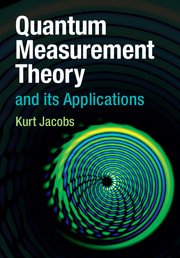Book contents
- Frontmatter
- Dedication
- Contents
- Preface
- 1 Quantum measurement theory
- 2 Useful concepts from information theory
- 3 Continuous measurement
- 4 Statistical mechanics, open systems, and measurement
- 5 Quantum feedback control
- 6 Metrology
- 7 Quantum mesoscopic systems I: circuits and measurements
- 8 Quantum mesoscopic systems II: measurement and control
- Appendix A The tensor product and partial trace
- Appendix B A fast-track introduction for experimentalists
- Appendix C A quick introduction to Ito calculus
- Appendix D Operators for qubits and modes
- Appendix E Dictionary of measurements
- Appendix F Input–output theory
- Appendix G Various formulae and techniques
- Appendix H Some proofs and derivations
- References
- Index
7 - Quantum mesoscopic systems I: circuits and measurements
Published online by Cambridge University Press: 05 September 2014
- Frontmatter
- Dedication
- Contents
- Preface
- 1 Quantum measurement theory
- 2 Useful concepts from information theory
- 3 Continuous measurement
- 4 Statistical mechanics, open systems, and measurement
- 5 Quantum feedback control
- 6 Metrology
- 7 Quantum mesoscopic systems I: circuits and measurements
- 8 Quantum mesoscopic systems II: measurement and control
- Appendix A The tensor product and partial trace
- Appendix B A fast-track introduction for experimentalists
- Appendix C A quick introduction to Ito calculus
- Appendix D Operators for qubits and modes
- Appendix E Dictionary of measurements
- Appendix F Input–output theory
- Appendix G Various formulae and techniques
- Appendix H Some proofs and derivations
- References
- Index
Summary
Superconducting circuits, photonic cavities, and tiny mechanical oscillators are versatile systems in which quantum dynamics can be observed and controlled. These various technologies can be combined, and the resulting “circuits” are often referred to as nano-electromechanical or optomechanical systems. In the context of quantum physics, such devices are referred to as “mesoscopic” because they contain a large number of atoms. This terminology distinguishes them from the “microscopic” systems of atom-optics, such as single ions [364] and atoms [545, 233, 26], and the spins of individual nuclei [412]. Nano-engineered systems provide an especially powerful arena for exploring quantum measurement and control because of their potential to realize complex circuits. In this chapter we explain how to treat these systems and describe in detail a common method used to measure them.
Superconducting circuits
The electrical circuits that we describe in this chapter are quite different from those that use normal conductors, such as copper wire at room temperature. Normal conductors are subject to strong dissipation and decoherence from the environment. As a result the dynamical degrees of freedom of the circuits, the currents and voltages, behave as classical variables. In superconducting circuits, the resistance, and thus the dissipation, is so small that the currents and voltages behave as quantum mechanical degrees of freedom. Of course, the current in a wire is actually composed of many elementary particles that each obey quantum mechanics. Why then should the current act like a single quantum degree of freedom? A mechanical analogy is useful here. Recall that even though a macroscopic pendulum is composed of many particles, when one talks about the motion of the pendulum one means the motion of the center-of-mass of its constituent particles. Since the center of mass is merely a linear combination of the coordinates of each particle, it is itself a valid quantum mechanical coordinate with a conjugate momentum. In a similar way the total current in a superconducting wire is a collective degree of freedom that obeys quantum mechanics.
- Type
- Chapter
- Information
- Quantum Measurement Theory and its Applications , pp. 323 - 382Publisher: Cambridge University PressPrint publication year: 2014



